Last Updated: 3/26
A couple of things to note before reading:
- These rankings are for 10- and 12-team head-to-head category leagues with standard scoring and a starting lineup consisting of 1 C, 1 1B, 1 2B, 1 3B, 1 SS, 3 OF, 2 UTIL, and a shallow bench, and were created by me with input from Nick Pollack.
- Within the write-ups, I will call out individual players who would see value boosts or drops in alternative formats, such as rotisserie leagues, deeper leagues, or points leagues.
- Projected stat totals assume that teams each play at least 145 games unless specifically stated otherwise.
- I am more than happy to answer your questions, requests, and counter-points on Twitter!
3/8 Updates:
- J.D. Davis dropped from Tier 6 to Tier 7.
- Tier 6 was re-ranked.
- Tier 7 was re-ranked.
3/26 Update
- Added injury note to Cavan Biggio.
- Kris Bryant was promoted to Tier 3.
Tier 1: Elite
No. 1: José Ramírez (Cleveland)
When you can hit 35 home runs, steal 25 bases, and have a career .281 batting average, you might end up in a tier all your own. While third base is considerably deep, no third baseman has the ability to contribute to all five standard offensive categories the way Ramírez can.
In fact, in 2020 there were only two players who managed to be in the top-10 in home runs, runs scored, RBI, and stolen bases—J-Ram and Fernando Tatis Jr. The only difference between the two, in terms of 2020 production? J-Ram beat Tatis in batting average, on-base percentage, and slugging by at least 15 points each. I’m not saying he is better than Tatis, I’m just calling out that he was, in fact, superior in some respects for this particular period of time.
Speaking of being a five-tool player, Ariel Cohen’s ATC projection system, which is a mash-up of a wide variety of other projection systems, only pegs five players to hit 30 or more home runs, steal 20 or more bases, hit at least .275, and have 190 combined runs scored and RBI. In other words, it projects that there are five players who will more than likely “do it all:” Ronald Acuña Jr., Fernando Tatis Jr., Mookie Betts, Trevor Story, and of course, José Ramírez.
A lot was made of the “slump” Ramírez went through at the end of 2018 and the beginning of 2019. It’s undeniable that his power numbers faltered a bit during that stretch, but as you can see from the rolling chart below, those dips were relatively short-lived compared to his sustained successes, and he seems to have fully adjusted to whatever it was that had sapped his power.
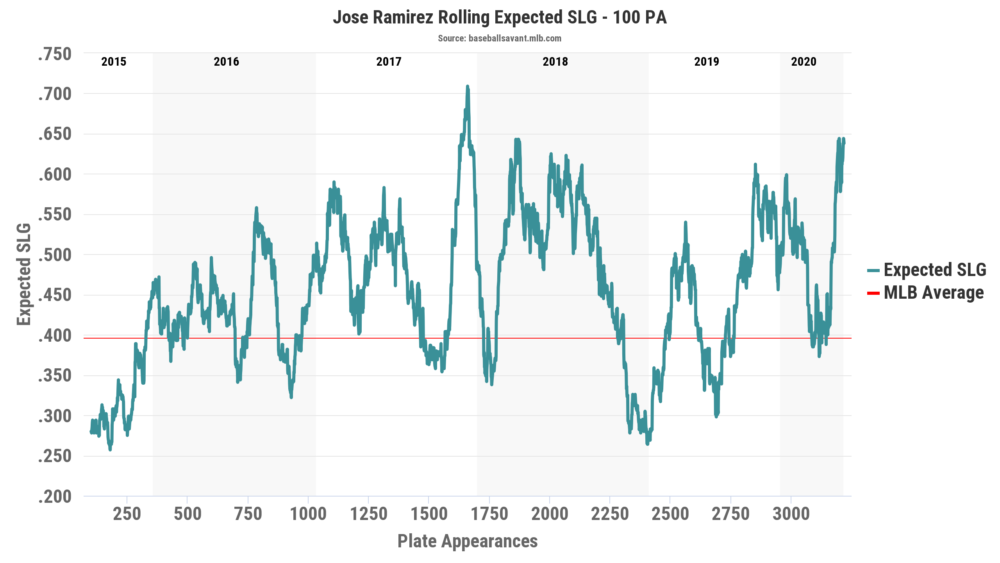
While the Cleveland offense is less intimidating than it once was, there should still be enough firepower for J-Ram do get it done for fantasy purposes. If you pick towards the back end of the first round, don’t be surprised to find J-Ram waiting for you there. I would not hesitate to scoop him up after pick seven (and if you really twisted my arm about taking him over one of the top two pitchers, I’d probably be OK with that, too).
Tier 2: Near-Elite
No. 2: Nolan Arenado (St. Louis Cardinals)
I know what you’re thinking—leaving Coors is going to be bad for his offense. If you’ll just give me a moment of your time, though, I’ll try to show you some other information that suggests that the move from Colorado to Missouri is much less impactful than it seems.
First, while Coors does provide an advantage to Rockies’ hitters when they’re playing at home, it hampers them once they go on the road by impacting their ability to adjust to how pitches move in normal atmospheric conditions. MLB’s Mike Petriello has written several excellent pieces on the topic, including this one specifically about Arenado.
Long story short, Arenado isn’t just going to become his road numbers, which have long been significantly below his home numbers. What’s more likely is that he’ll become slightly less dominant at home, and much better on the road. The two should mostly cancel each other out, though it doesn’t quite account for the mildly arming dip in production we saw in 2020:
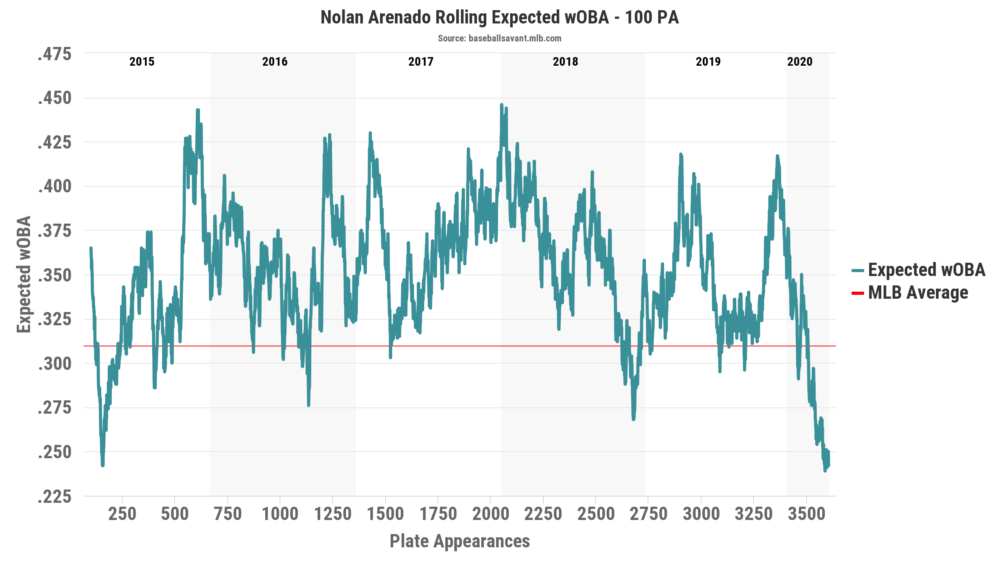
His expected wOBA ended up in the bottom 10% of the league, and the unstoppable king of consistency who had five consecutive 37 home run and 110 RBI seasons suddenly looked quite mortal. His 2020 pace would have resulted in just 27 home runs and 88 RBI over a 162-game season.
While these sorts of declines can be difficult to figure out, it’s actually pretty straight-forward with Arenado—he was hurt. A play he made in late July ended up lingering throughout the season until he finally went on the IL late in September after an MRI found swelling in his AC joint and a deep contusion.
With a full offseason to heal up and a rejuvenated spirit after leaving what had become a tense situation in Colorado, Arenado should return to being an excellent third baseman in both real and fantasy baseball.
While there’s some mild risk that he won’t quite get to 37 home runs or 110 RBI (which would have been a tall task even if he had stayed in Colorado due to the current state of that lineup), he should still clear 30 home runs and hit for a strong average. Plenty of counting stats should be there, too.
No. 3: Manny Machado (San Diego Padres)
We don’t have many questions about Machado’s bat—he’s a lock for over 30 home runs and should be able to hit at least .270, if not higher. With the dramatically improved lineup around him, 100 runs scored and 100 RBI should be well within reach too.
If we do have questions, it’s mostly around two things: will he steal bases, and will the bad luck monster find a way to drag his batting average down more than it should?
In the case of the former, there is some precedent for Machado stealing double-digit bases. He has done it in both 2015 and 2018; however, the follow-up seasons resulted in a combined five stolen bases. Machado isn’t much of a speedster (his percentile rank in sprint speed has been in the mid-30s since 2016), so most of his stolen bases come from intelligence and opportunity. While he did steal six bases in the shortened 2020 and is projected by many to swipe 10 in 2021, you’re likely better off penciling in five to seven and considering anything above that to be pure profit.
In the case of the latter, I honestly am not sure why luck seems to escape Machado and leave him with sub-.260 batting averages at times. His expected batting average numbers are considerably higher, and he’s not an extreme ground ball, fly ball, or pop fly hitter.
At the end of the day, you should feel very comfortable if you choose to take Machado at some point in the middle or the latter-half of the second round in a 12-team format and as one of the first 15-20 hitters off the board.
No. 4: Alex Bregman (Houston Astros)
Like many Astros, Bregman had a rough 2020 compared to his previous seasons. Between the scandal, the weird year, and the overall team struggles, it would be somewhat reasonable to give Bregman a bit of a pass on his 2020. After all, it was just one short season ago that he hit 41 home runs, scored 122 runs, and drove in 112 runners with an insane 17.2% walk rate to a 12% strikeout rate and a .423 OBP. Those are video game numbers!
To evaluate Bregman properly, I think you have to decide how you feel about his involvement with the scandal. There’s data on both sides about exactly what kind of hitter Bregman is with or without trash can signals, and I don’t really feel like debating it.
What I will say, though, is that while he didn’t chase that many more breaking balls in 2020 compared to his scandal-era days, he did miss those pitches he chased more often in 2020 than he did in 2018 or 2019. What’s more striking, though, is how little damage he was able to do against breaking balls in 2020:

See that blue line? That’s the one that often separates good hitters and bad hitters. In the modern game, it’s absolutely imperative that a hitter learn how to handle breaking pitches.
Unfortunately, I don’t have all the answers about who Bregman is. I have a hard time believing that he’s suddenly just a mediocre hitter, but I also understand how those signals could make him a better one. What I do know is that his plate discipline is still elite, and that the 26-year-old has two top-notch fantasy seasons under his belt. I’ve ranked him fourth at third base as a bit of a hedge—I think he may not be the juggernaut he was in 2019, but that he may be very much like the guy we saw in 2018.
3/26 Update: We haven’t seen a ton of Bregman in the spring, but the Astros have been doing that across the board. I’m not concerned yet.
No. 5: DJ LeMahieu (New York Yankees)
A reunion with the Yankees made the most sense from day one, as LeMahieu has been a different hitter since donning the pinstripes. After winning a batting title and logging many good-but-not-great fantasy seasons in Colorado due to limited power numbers but a robust batting average, the disciplined and versatile infielder showed that with a short porch and a robust lineup around him, he can hit for both contact and power, putting up a .922 OPS in his 192 games as a Yankee.
One interesting thing to point out about LeMahieu is that for fantasy purposes, New York is a much better place for him to hit than Colorado. While it may sound blasphemous, LeMahieu’s expected home runs by ballpark (as tracked by Statcast) across 2019 and 2020 would have been just 12 in Coors Field.
In Yankee Stadium, that number jumps to 40! Why? Because LeMahieu has learned how to take advantage of the short and low fences in the Bronx. In fact, none of the 81 batters with at least 10 home runs in 2020 had fewer expected home runs (according to Statcast) than LeMahieu, who came in at 6.8.
Now don’t get me wrong, this is not my attempt at suggesting the power is fake—in fact, far from it. Instead, this is my attempt at telling you that a return to New York was the ideal outcome for LeMahieu, as there are very few parks in baseball where he could translate his elite hit tool into 25 or more home runs, and New York is one of them.
I think many projection systems aren’t accounting for this quite enough, and would be very comfortable penciling in 25 or more home runs in 2021 to go along with a .300 or better batting average and tons of runs scored. Between that and his useful versatility, he should definitely be drafted among the first 15-20 hitters in your league.
No. 6: Anthony Rendon (Los Angeles Angels)
Well gang, it took the better part of a decade, but Rendon is officially no longer underrated. The career .290 hitter should take a boatload of walks, hit 30 home runs, and bring Mike Trout and David Fletcher back home about 100 times.
I think the only real discussion fantasy managers should have regarding Rendon is whether they want to move him up in this tier by a rank or two, and it’s mostly due to whether you think he’s more of a 30 home run hitter or more of a 25 home run hitter. Other than that, you probably know exactly what you’re getting with Rendon—a very good hitter.
No. 7: Rafael Devers (Boston Red Sox)
Frankly, the only real difference between Devers and the guys ranked above him are the lengths of their track records. Devers ends up at the bottom of this tier because, well, his track record is just significantly shorter than those of his colleagues.
If there’s one thing about Devers that I am skeptical of, it’s his stolen bases. As you may recall, Devers stole eight bases from the beginning of the 2019 season through June 5. The thing is, Devers didn’t steal a single base after that, and to make matters worse he’s got caught five times and ended the season with just a 50% success rate. That just won’t play in the big leagues. With that in mind, it would probably not shock you to learn that Devers didn’t even attempt to steal a base in 2020.
To be clear, though, I am not skeptical at all about Devers’ bat. I think he’s an excellent young hitter. As it stands, LeMahieu, Bregman, Rendon, and Devers are really close for me in terms of overall value, and will likely all go within 10-15 picks of each other, so while five projected home runs seems trivial, when the competition is as tight as it is with these three, they end up making a difference.
There are a plethora of scenarios where you re-order this entire tier based on your personal preferences and beliefs. While I do feel pretty good about how I’ve ranked them here, I can’t really call anyone unreasonable if they choose to mix things up.
Tier 3: Solid
No. 8: Cavan Biggio (Toronto Blue Jays)
Let me tell you why I like Biggio so much. First, in the 159 games we’ve seen from Biggio so far, he’s hit 24 home runs, stolen 20 bases, and hit .240 with a strong .368 OBP.
Second, he’s made considerable improvements to his strikeout and whiff rates, which is particularly important for Biggio because he rarely swings in the first place. Finally, he’s a guy with pop and speed who can get on base. Having all three of those qualities is a wonderful thing and not something we should ever take for granted.
At one point this offseason, this tier was headlined by Biggio, but exactly one thing has caused me to lower him to the bottom (which, if nothing else, tells you how tight I perceive this tier to be)—his spot in the batting order.
Until the signing of Marcus Semien, Biggio was slated to bat in the two-hole, as he had most of the time during his time in the big leagues. That particular spot is absolutely ideal for Biggio’s skillset. Being near the top of a strong Blue Jays lineup meant plenty of opportunities to score runs, as evidenced by the 107 runs he’s already scored in his 159 games.
It also means a few more chances to steal bases for a player with his speed and walk rates. Lastly, and most importantly, it probably would have led to about 50 more plate appearances on the season (there are a plethora of great articles on the topic of plate appearances by lineup spot, so here’s one by Joe Douglas of Rotographs that I find very approachable).
Roster Resource currently projects Biggio to now bat sixth, so instead of the heart of the order behind him, he gets the bottom of it. On the plus side, it should give him more RBI than we’ve seen from him thus far; however, his approach isn’t terribly well-suited to driving in runners as he doesn’t routinely make great contact and much of his on-base ability is driven by walks. It doesn’t mean he can’t still produce, but it does lower his ceiling just enough to put him at the bottom of this tier instead of the top.
If you play in a league that focuses on OBP instead of batting average and also has stolen bases as a premium, go ahead and put Biggio at the bottom of the previous tier if you wish. His high walk rates keep his ratios in excellent shape, and there aren’t many third basemen who steal bases.
3/26 Update: He’s had some finger discomfort, but looks OK for Opening Day.
No. 9: Eugenio Suárez (Cincinnati Reds)
Remember when he was a Detroit Tiger, and then they traded him for…Alfredo “Big Pasta” Simón? Sigh…
Anyways, Suárez has come a long way from the scrappy utility infielder with gap power that he was in 2014. Since the start of 2018, exactly one hitter has more home runs than Suárez—some guy named Mike Trout. Whenever that guy is the only one ahead of you on a leaderboard, you know you’re doing pretty darn well.
While that’s all well and good, a disturbing trend seems to be appearing in Suárez’s profile:
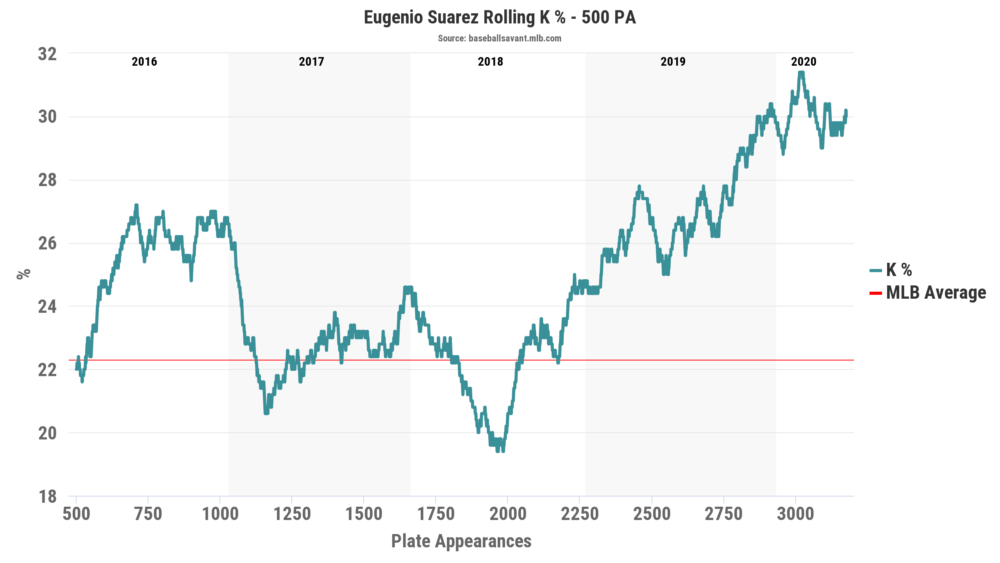
While I normally don’t use 500 plate appearances as the roll for these charts, it can be quite helpful when looking at players with long track records, especially when the shorter trends are too volatile to quickly process.
Essentially, since mid-2018, Suárez has become more and more vulnerable to third strikes, and it came to a head in 2020 when he ended the season with a .202 batting average and an almost equally disappointing .218 expected batting average.
While his barrel rate and walk rate came up, it wasn’t nearly enough to offset the elevated strikeout rates. He’s not only chasing more pitches out of the zone and missing, but he’s also just missing more often on pitches in the zone, and that’s the piece that’s more alarming.
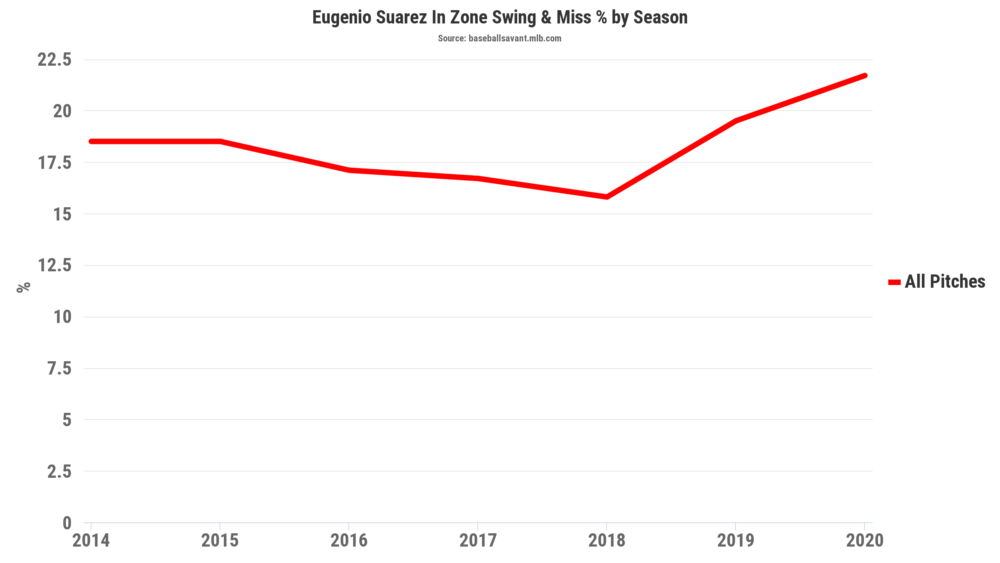
While he has more than enough power to clear 40 home runs, what remains to be seen is how he can overcome these newfound holes in his swing. If he can correct it, he’ll be higher on this list in 2022. If he can’t, well, let’s not think about that unless we have to—but it means not-so-good things for his value in deeper formats and roto leagues.
To end on a happier note, at least the improved walk rate makes the potential ratio hit less painful in OBP leagues.
No. 10: Matt Chapman (Oakland Athletics)
For the third straight season, Chapman was in the top 4% of hitters in exit velocity. He also made a dramatic improvement to his ground ball rate, going from back-to-back seasons over 40% all the way down to 25.8% in 2021, with most of those grounders turning into line drives.
The thing is, some other weird stuff happened too. For example, he also took 10 points off of his fly ball rate and turned those into line drives, too. He also started pulling the ball much more often, and to top it all off, he started whiffing and striking out at an alarming rate, going down on strikes 35.5% of the time. Some of this is probably attributable to his elevated chase rate, but he also missed at more things in the zone as well, including fastballs.
As you might expect, it’s hard to look at the numbers and pinpoint a root cause for the good and bad things for Chapman, and sometimes the simplest explanation is the best one—it’s just 2020 being 2020. We’ve seen enough of Chapman to know that he’s an elite defender at third base and has a ton of power.
Draft him for the 35-40 home run power and a plethora of counting stats while accepting that the batting average will be under .250. I think it’s unlikely that you’ll be disappointed.
Tier 4: Back-End Starters
No. 11: Yoán Moncada (Chicago White Sox)
Moncada is a really tough guy to evaluate for 2021 because while we know that COVID-19 impacted his play, it’s nearly impossible to know the true extent. With that in mind, I suppose we should assess the things we do know—for example, we know that Moncada’s plate discipline looked a lot more like it did in 2018 than it did in 2019, and that 2019 was the breakout year.
We also know that much of his batted ball profile looks like what he did in 2018 and 2019 except that the power was just sapped from him and his bat. This particular part of the narrative, by the way, is the part that is easiest for me to attach to his issues with COVID. Recovering from illness, particularly respiratory ones, can take a lot of out of our bodies and it makes sense that it could slow his bat down and rob him of some power.
Finally, we also know that a healthy Moncada is a freakishly athletic baseball player who is absolutely capable of hitting 30 home runs, stealing 10 bases, piling up 100 or more RBI, and hitting for a high average.
While we’ve only seen glimpses of that player, I think we’ve seen enough to know that such talent dwells within. Moncada’s spot in these rankings is an attempt to balance the risk of his profile, which can lead to low batting averages and a demotion to the bottom of the order, with the top-five upside he can provide.
As a final word, it should be noted that those in OBP leagues will have significantly less risk, as he should maintain a .320 or better OBP even if he gets mired in a slump or two.
No. 12: Max Muncy (Los Angeles Dodgers)
Muncy is similarly situated in the first and second base rankings, but with first and third having a deeper pool, most managers will likely opt to plug him in at second base. Here’s most of what I wrote about him in those rankings:
He’ll hit 30 home runs. He’ll walk 15% of the time. He’ll drive at least 90 runners and score at least 90 times. I feel good about all of that, and let’s be clear—that is a lot to feel good about. Strong production in three categories is a big deal.
The only thing that makes me feel at all uneasy was that he seemed to struggle with was keeping the ball off the ground. In what we saw in 2020, pitchers attacked him with fewer fastballs than ever before, which is meaningful as the vast majority of Muncy’s damage has been from smashing fastballs.
Pitchers, and in particular, right-handed pitchers, focused on locating breaking and offspeed pitches down beneath the zone and locating fastballs up and on the outer half of the plate.
While Muncy still managed to take walks and hit home runs, it crushed his batting average. While he was a bit unlucky on fastballs, both traditional and Statcast metrics indicate that the struggles against non-fastballs were very real.
This is not to suggest that Muncy is doomed forever—pitchers change how they approach hitters all the time, and hitters have always needed to adjust accordingly. I firmly believe the power and counting numbers will remain strong, but until Muncy finds a way to avoid weak contact on those pitches beneath the zone, his batting average floor and propensity for extended slumps could be rough.
Just to end this on a positive note—OBP players should be wholly unconcerned with his batting average woes, as even after hitting below .200 in 2020, he kept his OBP north of .330.
His 15% walk rate keeps his floor in those leagues considerably higher, and if these rankings were geared towards that format, Muncy would probably lead off this tier (or possibly even crack the tier above).
No. 13: Jeff McNeil (New York Mets)
Being able to hit .310, steal close to 10 bases, and reach 20 home runs in a season is quite respectable, and batting second in a suddenly formidable Mets lineup makes it all the sweeter.
While his batting average is elite, he has historically not turned many heads with his counting stats. While I definitely expect a boost in those numbers with a stronger lineup around him, I highly doubt we see McNeil clear 25 home runs or 90 RBI.
That said, he puts a ton of balls in play and can play multiple positions in both real life and fantasy, and that versatility makes him an attractive fantasy option.
On that note, points leaguers should consider sliding McNeil up their board as well due to his fantastic plate discipline and a spot near the top of the batting order. Those in OBP formats should also slide him up a bit, as his OBP of .384 since the start of 2019 is 14th in all of baseball.
If you’ve taken a couple of risks early on in your draft and need a versatile high-floor player, McNeil is your guy. If you are looking for upside because you have a safe foundation to start, you might instead wait for a few rounds and target some of the players in the next tier or two.
No. 14: Alec Bohm (Philadelphia Phillies)
I also wrote up Bohm in the first base rankings, where he wound up one spot higher than he does here. Here’s the write-up I have of him from over there:
Frankly, the 44-game sample we saw from Bohm in 2020 is all we really could have asked for from the 24-year-old righty. The former first-round pick is praised mostly for his outstanding hit tool, which I’ve seen scouts grade as high as 70 on the 80-point scale.
Bohm was able to flash that advanced bat right away for the Phillies, batting .338 with just a 20% strikeout rate in his first stint at the major league level despite just 63 games in Double-A ball.
While Bohm does have pop, I don’t think he’ll be a 30 bomb kind of hitter. Instead, he’s probably more of a 20-25 home run guy with a .290 batting average who can also swipe a handful of bags and is in a prime spot hitting second behind Andrew McCutchen and in front of Bryce Harper, J.T. Realmuto, and Rhys Hoskins. Assuming he can stay in that spot, counting stats shouldn’t be too tough to come by, either.
No. 15: Kris Bryant (Chicago Cubs)
For a guy who had a 135 wRC+, 31 home runs, and 108 runs scored in 2019, there sure seem to be a lot of folks who think he’s washed up. Entering his seventh major league season at age 29, Bryant has fought through two rough seasons marred with injury and ineffectiveness (2018 and 2020) but also has four very good ones.
Before the small sample season of 2020, Bryant had never finished with a batting average below .272, hit fewer than 26 home runs, or slugged below .488 in any season where he played at least 140 games. That type of consistency is hard to find in the modern game. Even just typing this out makes me wonder why I have him ranked 15th!
I suppose a large part of it is just how rough 2020 turned out for Bryant. A .208 average leaves a bad taste in anyone’s mouth, but more than anything else, it’s probably this rolling chart:
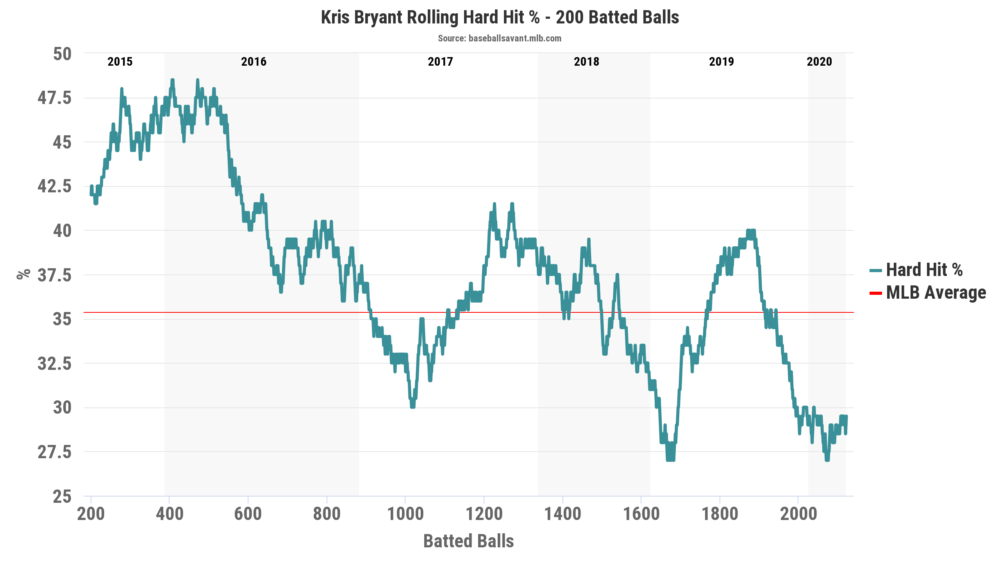
As you may recall, the first two sections of the chart have great numbers! He was the Rookie of the Year in the National League in 2015, then followed it up with an MVP win in 2016. Since then, however, Statcast has been a bit skeptical of his results, grading him as a mostly average player.
While stranger things have happened than a player of Bryant’s caliber turning things around and being a top-10 option at the position, it feels more likely at the moment that he’ll be more like a replacement-level option in 10- and 12-teamers, particularly in leagues that don’t require a corner infielder.
Tier 5: Deep League Options
No. 16: Gio Urshela (New York Yankees)
I’m not going to go into many details about why Gio’s exceptional work over the last two seasons may very well be legit, because Lucas Zenobi already did it. If you check it out, you’ll that there are a lot of things to like. So why do I have him so far down these rankings? Well, two reasons:
First, this position is just really deep! Up until now, we’ve been talking about players with the potential to finish within the top-10 third baseman, and Urshela is no different. I can certainly see him batting .285 with 25 home runs in a full season; however, because I expect him to bat near the bottom of the Yankees’ lineup, his runs scored and RBI are pretty capped.
Second, there’s a touch of uncertainty around Urshela, especially if he is merely an average player for any amount of time. The Yankees have a crowded bench as it is, and that doesn’t even include Miguel Andújar, who was optioned towards the end of last year.
With the DH blocked up by Giancarlo Stanton, and Urshela not really experienced in other positions, players like Clint Frazier, Mike Ford, Mike Tauchmann, and Andújar could force their way into playing time, and at least some of it would likely come at Urshela’s expense.
I think Urshela is probably better than these folks, but there are only nine spots in the lineup, and Urshela’s spot is probably a bit more vulnerable than many of his teammates (assuming they are healthy). Even so, that tiny bit of risk combined with the lack of an extended track record and a slightly limited upside is enough to be ranked here.
No. 17: Josh Donaldson (Minnesota Twins)
This is an easy one—a healthy Donaldson hits a whole bunch of home runs, gets on base at a high clip, and drives in buckets of runs for the Twins. That’s very, very good. The issue, of course, is that we’ve only had a healthy Donaldson once over the last four seasons.
Projections will be tough to use for Donaldson because injuries are nearly impossible to predict. I would probably not recommend Donaldson as a starting third baseman in a 10- or 12-team format unless you’re in an OBP league or you’ve properly prepared to handle the risk (because you drafted someone like LeMahieu or McNeil who can provide some flexibility and give you more options on the wire.
No. 18: Marcus Semien (Toronto Blue Jays)
Despite a .223 batting average in 2020, Semien still showed off the improved walk rate he had in 2019 along with decent power and speed. While I would have really loved to see him also keep up with the 13.7% strikeout rate, it just wasn’t in the cards.
Regardless, it’s hard to put into words how great everything was in 2019. He truly looked like a brand new player…until he didn’t anymore.
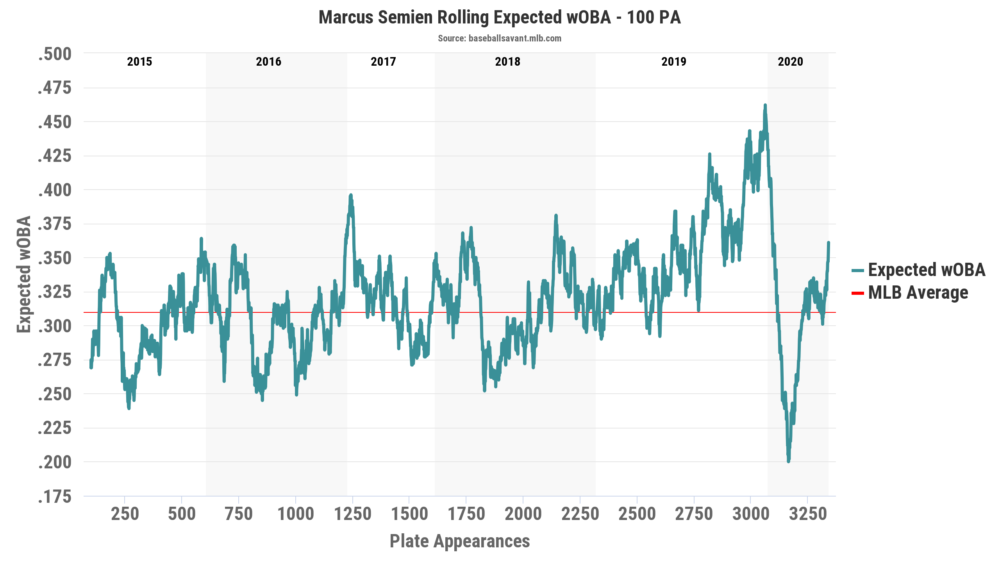
For the time being, Semien looks locked in towards the top of the Blue Jays lineup, so his 20-25 home run potential should come with plenty of counting stats and maybe even double-digit stolen base totals. There’s also a chance, though, that he just can’t get on base quite enough to justify having him bat second instead of Biggio or one of the other talented Blue Jays.
Tier 6: Even Deeper League Options
No. 19: Ke’Bryan Hayes (Pittsburgh Pirates)
There are a lot of things to like (obviously) about what Hayes brought to the table in 2020. Not only were the results strong, but he performed against all pitch types and had promising plate discipline for such a young player. It’s always a big plus when a player debuts and maintains a similar walk and strikeout rate that they had in the minors.
Despite all that promise, I think we have to recognize that Hayes was fortunate in 2020 and that several factors will likely limit his upside in 2021. In the minor leagues, Hayes never had more than 10% of his fly balls leave the yard. In his first stop in the major leagues, 25% of his fly balls made it over the fence. Hayes actually did not hit a single No Doubter, which is a Statcast measure of a home run that would have left the yard in every ballpark.
That stroke of luck with fly balls is very unlikely to return in 2021, especially with the news that five more teams are adding a humidor and that they’re making a change to the ball itself. Now, even without luck, Hayes is an exciting young player. That said, I wouldn’t be counting on 20 home runs or 10 stolen bases from Hayes, and clearing 80 runs or RBI will be a high hurdle on a weak Pittsburgh offense.
I do think he can hit for a .270-.275 batting average, though, and the final line should be very useful for a corner infielder for fantasy purposes. I wish I could paint a rosier picture, but in a 10- or 12-team league with no corner infield position, Hayes looks more like a replacement-level guy than an impact one.
No. 20: Austin Riley (Atlanta)
Our own Chad Young wrote an excellent piece on why Riley may be a breakout candidate in Atlanta this season, and if you’re looking for a “sleeper” (if that’s even a thing anymore), I recommend you read the piece.
Riley’s primary issues are that he’s struggled to find playing time and that he has gone through some awful cold spells. As to the former, the various moves by Atlanta this offseason leave Riley as the last man standing (probably) to be the regular third baseman.
Even if there’s no DH in 2020, I think Riley should play at least 80% of the time assuming he’s productive. As to the latter, here’s a little rolling chart to show what I mean:
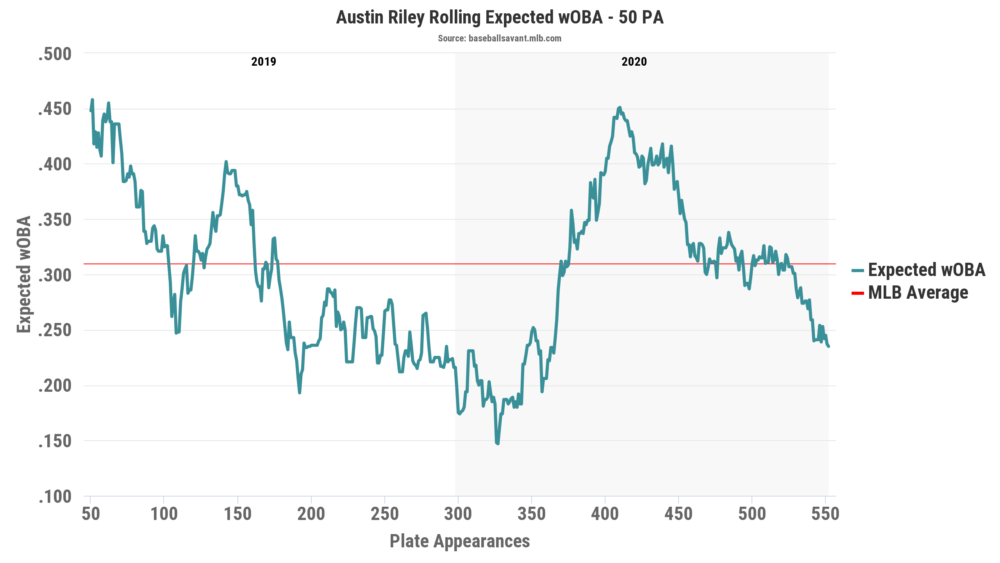
That big valley in the middle? That was a player who you couldn’t even roster in a mixed 15-teamer. Riley is always going to struggle with batting average, and when the power disappears he becomes a real fantasy sandbag. Of course, if he can put some things together and raise that floor from super-duper bad to just regular bad, then he becomes much more palatable as a fantasy option.
Riley should be pretty easy to scoop up at the very end of a 12-team draft and if your league is one where it makes sense to stash a hitter or two, Riley is as good a candidate as any to take a flyer on and see what happens.
No. 21: Justin Turner (Los Angeles Dodgers)
We know he’s going to hit close to .300, we know he’s can hit 20-25 home runs if he plays 130 games, we know he’s going to be on the IL for a little while, and we know that he’s going hit near the middle of the Dodgers’ lineup. This move was always the most likely, and for fantasy purposes, Turner in LA is an easy thing to project because we’ve seen it since 2014 and the outlook is basically the same.
Turner’s ADP has been suppressed by the relative uncertainty of his landing spot, and if you missed out on all of your targets in the first five tiers, Turner isn’t an awful 12-team third baseman to help you tread water until you find something a little better during the season. He’s also a nice fit if you find yourself a little light in RBI, as he’s slated to bat third on what should be one of baseball’s best teams.
No. 22: Tommy Edman (St. Louis Cardinals)
If you must start Edman at a position, it will probably be at second base. Here’s what I wrote about him over there:
I am admittedly unsure of what to make of Edman. On one hand, his 147 major league games as a whole are quite impressive—88 runs scored, 16 home runs, 17 steals, and a .283/.337/.449 line. Unfortunately, it’s not exactly a case of balanced production.
After exploding onto the scene as an almost entirely unheralded prospect, Edman has been mostly average except for a few bursts at the start and end of his 2019 campaign and a little bit at the start of 2020.
While I suppose you could talk yourself into a 20 home run, 20 stolen base season by squinting a little and focusing on 2019, you can just as easily see the downside of a 15 home run, six stolen base season with a mediocre batting average. The latter is not useful in a shallow league, I’m afraid, and while his ceiling is a decent piece to a 2021 puzzle, I’d be looking for more upside in a 10- or 12-team league.
On the other hand, deep-league players will find value in his versatility that makes chasing the upside a bit more tantalizing. Edman is a classic example of a player whose value changes drastically when more teams and roster positions are added and his positional eligibility and stolen bases really shine.
No. 23: Andrés Giménez (New York Mets)
Giménez is more likely to cover a second base or middle infield spot, and does find himself ranked higher there than he does here due to the depth of third base. Here’s what I wrote about him in those rankings:
The signing of Cesar Hernandez sort of mucks things up for Giménez, who was previously slated to bat at the top of the order.
There’s also a non-zero chance that Giménez is forced to platoon at times with Amed Rosario when facing tougher left-handed pitching. The path to reaching his ceiling grows foggier every day, and when the upside was already a fringe starter in standard leagues, it becomes tough to make Giménez a draft-day target. As of March 8, this is becoming more and more worrisome as a possibility.
Of course, as with most speedsters, deep-league managers will want to slide Giménez up their boards if they are still looking for steals later on in the draft, and his eligibility at second, shortstop, and third provides wide infield coverage.
I’m willing to put Giménez back in the previous tier if Rosario is traded or Giménez wins the job outright. Until then, though, I’m too scared to count on him in a 10- or 12-teamer.
No. 24: David Fletcher (Los Angeles Angels)
Another multi-positional guy who is primarily going to be a second baseman for fantasy, so here’s the writeup from that section:
I love Fletcher, and that’s why he’s so high up in [the second base] rankings. Sure, he probably won’t get 10 home runs or 10 steals, but he’ll hit close to .300 and it’s not hard to envision 90 or more runs scored when he’s leading off for a top-heavy offense.
In virtually all formats, you should be able to slot Fletcher in at second, shortstop, or third base, and he’ll provide elite batting average and strong runs scored, although not a whole lot else. He’ll be rostered at some point in your 12-team leagues because of injuries or because he’s a bit hot, and points league players will probably even draft him as their last hitter due to how often he puts the ball in play.
You probably don’t want him as your starter for a full season, though, unless you’re in a 15-team format that uses middle and corner infield spots.
Tier 7: Dart Throws and Bench Guys
No. 25: Kyle Seager (Seattle Mariners)
It’s not as though the “other” Seager is without upside—he’s hit 32 home runs and driven in 103 Mariners over his last 166 games and improved his plate discipline dramatically in 2020. His tendencies towards fly balls and occasional cold streaks will keep his batting average a bit low, but I wouldn’t be terribly shocked if he hit 25 home runs in 2021.
I also wouldn’t be terribly shocked, though, if he hit 22 home runs with a .221 batting average like he did in 2018. Other than 2019, he’s been a durable player and has at least 20 home runs in every full season since 2012. There’s a hint of upside here, but in a 12-team league with no corner infield spot, you can probably afford to stick him on your watch list.
No. 26: Brian Anderson (Miami Marlins)
Anderson is an accumulator—he’ll play over 150 games and bat fourth behind the not-terrible part of the Marlins order, so he’s likely to claw his way to 85-90 RBI while hitting around 20 home runs with a .260-something batting average.
In a 15-team format, that’s a serviceable corner infielder, and in deep Yahoo leagues, his carry-over outfield eligibility from 2019 is marginally useful. In a 10- or 12-teamer, though, this is a non-factor.
No. 27: Jeimer Candelario (Detroit Tigers)
The 27-year-old corner infielder flashed some promise during 2020, batting .297 with respectable plate discipline and a little bit of pop. Statcast mostly believed in the results through an expected batting average of .277 and an expected slugging of .469, and those kinds of numbers would be an appealing site for my sore Tigers’ fan eyes.
My guess is that the real Candelario is more like a guy who can hit 20 bombs and maybe bat .260 or so, and while that’s perfectly acceptable for real baseball or an AL-only league, it’s no good for shallow 10- or 12-teamers, regardless of whether they have a middle infield slot.
No. 28: J.D. Davis (New York Mets)
In years past, batting seventh for the Mets was a yucky place for a hitter to be, as there wouldn’t be a ton of counting stats to accumulate in the bottom-third of what was usually a weak lineup.
These days, however, Davis could still push towards 75-80 runs scored and RBI due to the additions to the lineup. The righty is also a Statcast darling due to his impressive quality of contact, though it has yet to manifest itself as gaudy home runs totals.
The only real issues for Davis are that his batting average is neutral, he doesn’t steal bases, and he’s just short of being an everyday player due to the insane flexibility on the Mets roster. At this point, it’s hard to envision more than 100-120 starts, and that’s not a good path to 10- or 12-team relevance.
No. 29: Eduardo Escobar (Arizona Diamondbacks)
Other than the actual results, Escobar’s 2017 looked about the same as his 2019. In fact, when you look at the rolling chart, you’d never suspect that the 2019 section of it brought him and fantasy managers a 35 home run, 118 RBI season:
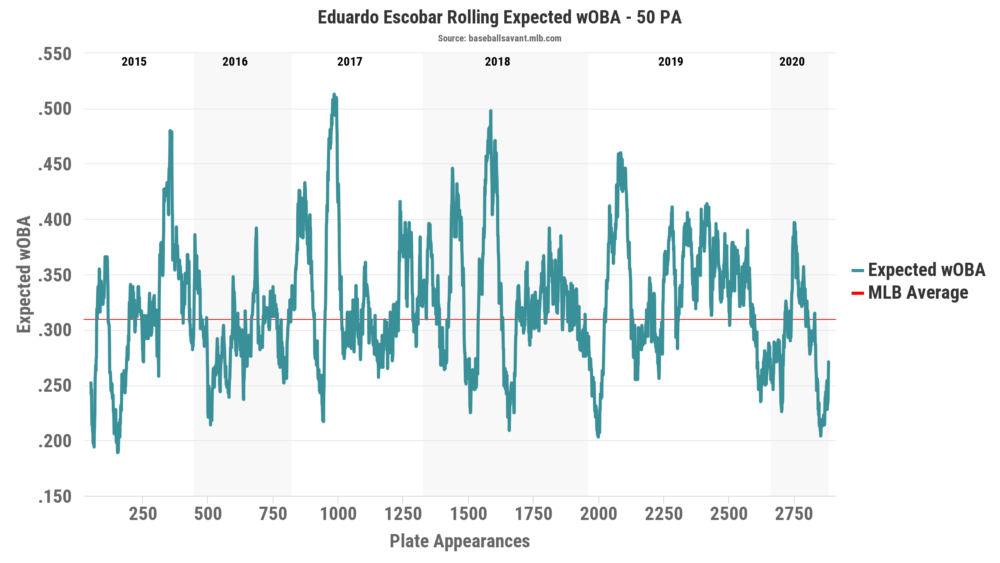
I was never a huge believer that Escobar would repeat on his career year, though 2020 was also a bit more dismal than I expected. I suspect that the 32-year-old third baseman has a ranged of outcomes between a back-end or replacement third baseman in fantasy and waiver-wire fodder.
No. 30: Willi Castro (Detroit Tigers)
I don’t usually use these percentile rankings from Statcast to make a point, as generally speaking, a lot of the stats are redundant. If you have a high exit velocity, you’re going to have a high Hard Hit rate. If you have a high xwOBA or barrel rate, you’re going to have a high expected batting average and expected slugging percentage. It just doesn’t always provide a variety of information.
And then there’s Castro, who has percentile rankings that befuddle and perplex me:
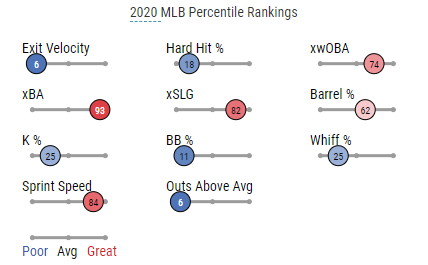
It’s pretty weird to see such poor exit velocity numbers and such high expected stats and a good barrel rate, but here we are. I kept wondering if I had ever seen this before, and then I realized that I had—Luis Arraez. Arraez has similar career numbers in that he has very low exit velocity but a decent barrel rate and expected stats.
Both hitters hit a lot of grounders and line drives and few fly balls, and generate a ton of singles by getting between the infielders and outfielders. That’s not going to be enough to clear the fences all that often, though, unless you sell out a bit for power when you think you have a good pitch.
Arraez really doesn’t do that, and that’s why he never seems to strike out or walk. Castro, however, does do that. Unfortunately, because he doesn’t have much stolen base prowess and is extremely risky due to his aggressive approach and limited experience, he’s more of a flyer for me than anything else.
Honorable Mentions
Isiah Kiner-Falefa (Texas Rangers)
He’s ranked well at catcher (and he can be deployed there in Yahoo formats), and if these were ranked in the order I’d draft them, he’d be up quite a bit higher (obviously). That said, as strictly an infielder, there’s not a ton to get excited about here besides double-digit steals. It’s going to be a long summer in Texas.
Ryan McMahon (Colorado Rockies)
He’ll play, he’ll hit 25 home runs or so, and that’s all we really can say about him. He’ll be streamable in DFS or extremely deep daily leagues when facing favorable matchups in Coors (he’s considerably better against lefties than righties, though still quite average), and that’s about it.
Edwin Ríos (Los Angeles Dodgers)
If he hit 30 home runs with a .250 average in 2021, what would be the most surprising thing about it? The playing time, right? The signing of Justin Turner hurts Ríos in a big way, as he now needs a new position to open up for him (and I’m not expecting the DH until 2022). There are just so many ways that Ríos could wind up with fewer than 110 starts, and that means he’ll be on the 12-team waiver more than once this season.
Jean Segura (Philadelphia Phillies)
He’s actually ranked at second base. Another guy who will have a place on deep league rosters over some of the back-end options in the prior tier, Segura should get somewhere between 12-15 home runs and steals with a pretty-OK batting average and some average counting stats.
He’ll bat near the bottom of the Phillies order, though, and there’s a very real chance he puts up another ho-hum 12 home run, 10 stolen base season like he did in 2019. While he still has some wheels, his quality of contact leaves a lot to be desired and he’s more of a boring accumulator for deep leagues than he is anything else. He’s very useful in a 15-team rotisserie league for the volume and steadiness, though.
Had this been a deep rotisserie league, I’d be comfortable moving Segura to the bottom of Tier 5. It sounds crazy, but his ceiling is barely playable in a shallow league, which makes his excellent floor fairly meaningless.
Carter Kieboom (Washington Nationals)
This time last season, Kieboom was a top-20 fantasy prospect with a lot of buzz. These days, despite being the odds-on favorite to win the third base job in Washington, he can’t crack the top 30 third baseman? Are fantasy analysts that fickle?
Well, 165 plate appearances of a .181 batting average and a .232 slugging has a way of souring folks on a player who was supposed to have an advanced hit tool and plus power. There’s definitely still upside here, but you might want to watch from afar first to see if he’ll have a chance to realize it in 2021.
Joey Wendle (Tampa Bay Rays)
As I said in the second base rankings, call me if he ever gets a full time job, as he might have enough batting average and speed to be bench-worthy in a 15-team league.
Isaac Paredes (Detroit Tigers)
I love Paredes hit tool and think he has enough power where he could get to 20 home runs with a strong average. That said, he doesn’t have a prototypical build for an athlete. At 5’11 and weighing in at 225 pounds, he’s got the overall build of Willians Astudillo (who I absolutely adore), and while he’s more than athletic enough to hit the ball hard, his fantasy upside is capped by his utter lack of speed.
Maikel Franco (Free Agent)
Franco hadn’t looked this good since 2018, but he’s now unemployed and it’s hard to see an obvious fit where he’d threaten to play every day. He’s barely on the radar in deep leagues with a full-time gig, so he’s totally off it without one.
Photos by Frank Jansky & George Walker/Icon Sportswire | Adapted by Justin Redler (@reldernitsuj on Twitter)
